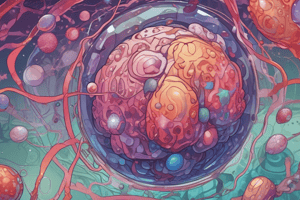Podcast
Questions and Answers
What are autacoids?
What are autacoids?
Autacoids are diverse substances produced by a wide variety of cells in the body, having intense biological activity, and generally act locally.
Which of the following is NOT a major class of autacoids?
Which of the following is NOT a major class of autacoids?
- Biogenic amines
- Polypeptides
- Hormones (correct)
- Lipid-derived autacoids
What are the primary tissue sites storing histamine?
What are the primary tissue sites storing histamine?
Lungs, skin, mucosal layer of the stomach, and basophils.
Histamine is primarily produced by red blood cells.
Histamine is primarily produced by red blood cells.
What triggers the immune release of histamine from mast cells?
What triggers the immune release of histamine from mast cells?
Name two drugs that can induce the release of histamine.
Name two drugs that can induce the release of histamine.
Histamine functions as a neurotransmitter in the ______.
Histamine functions as a neurotransmitter in the ______.
Which of the following statements about autacoids is TRUE?
Which of the following statements about autacoids is TRUE?
Which type of hypersensitivity reaction involves the release of histamine from mast cells?
Which type of hypersensitivity reaction involves the release of histamine from mast cells?
Flashcards are hidden until you start studying
Study Notes
Autacoids
- Autacoids are locally acting substances produced by various cells in the body.
- They are often called "local hormones" and are involved in various physiological and pathological processes.
- Autacoids differ from hormones because they act locally at the site of synthesis and release. Hormones are transported through circulation to act on distant target tissues.
Major Classes of Autacoids
- Biogenic amines: Histamine and Serotonin (5-hydroxytryptamine)
- Polypeptides: Plasma kinins (Bradykinin, Kallidin, angiotensin)
- Lipid-derived autacoids: Eicosanoids (Prostaglandins, leukotrienes, thromboxane), and Platelet activating factor
- Other autacoids: Cytokines (interleukins, TNFα, GM-CSF) and peptides like gastrin, somatostatin, vasoactive intestinal peptide.
Histamine and Related Drugs
- Histamine is a biogenic amine primarily produced by mast cells and basophils.
- Mast cells and basophils are abundant in the skin, gastrointestinal tract, and respiratory tract.
- Histamine also acts as a neurotransmitter in the central nervous system (CNS).
Synthesis and Degradation of Histamine
- Histamine is synthesized from the amino acid histidine via the enzyme histidine decarboxylase.
- The primary enzyme responsible for histamine degradation in the body is histamine N-methyltransferase.
Distribution and Storage Sites
- Primary tissue sites storing histamine are the lungs, skin, mucosal layer of the stomach and basophils.
- Mast cells are the primary cells that store histamine in storage granules alongside heparin sulfate and chondroitin sulfate E.
- Histamine is also found in the central nervous system (CNS).
- Venoms and insect stings contain histamine and other biologically active substances.
- Histamine is also found in the digesta where it is mainly produced by bacterial action.
Release of Histamine
- Release of histamine from mast cells can be triggered by:
- Energy- & Ca2+-dependent degranulation reaction (Immune release): Immunoglobulin E (IgE) fixation to mast cells (sensitization) and subsequent exposure to a specific antigen triggers degranulation.
- Energy- & Ca 2+-independent release (displacement) or Drug-induced release: Drugs such as morphine, tubocurarine, guanethidine, and amine antibiotics can displace histamine, causing its release. This does not involve degranulation or mast cell injury.
- Polymers like dextran, polyvinyl pyrrolidone(PVP) can also displace histamine.
- Mast cell damage: Noxious agents like venom or mechanical trauma cause mast cell damage, releasing histamine.
Studying That Suits You
Use AI to generate personalized quizzes and flashcards to suit your learning preferences.




